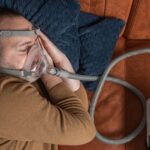Introduction
Panic attacks can be terrifying, with symptoms like shortness of breath, rapid heartbeat, and chest tightness. These physical symptoms can mimic a respiratory issue, making it hard to distinguish a panic attack from a breathing problem. Thus, some wonder if an asthma inhaler can help during a panic attack. In this article, we will discuss can you use an inhaler for panic attacks and how inhalers may be harmful and beneficial to treat panic attacks.
Can You Use an Inhaler for Panic Attacks?
Panic attacks can be overwhelming and debilitating experiences. They often cause chest pain, tightness, and rapid heartbeat. Panic attacks are usually associated with anxiety, but asthmatic patients can also have them. This raises the question of whether asthma inhalers can also relieve panic attack symptoms. This question can be answered by evaluating harms and benefits of using inhalers for panic attacks.
Panic attack sufferers use inhalers as safety behavior. Some patients use their inhaler to relieve symptoms like chest pain, chest tightness, and rapid heart rate. Inhalers can temporarily relieve panic attacks, but they have pros and cons. Benefits include feeling in control and fast relief from chest tightness and breathing problems. An inhaler may also help panic attack sufferers with asthma or asthma-like symptoms.
Why Inhalers shouldn’t be used in panic attacks
Inhalers in panic attacks may help temporarily, but they also have risks. Inhalers may not be enough to manage panic attacks.
Firstly, inhalers don’t treat the cause of anxiety. Stress and anxiety disorders can cause panic attacks. Treating physical symptoms with an inhaler may cause dependency and not provide long-term relief.
Using an inhaler to manage panic attacks can also hinder coping and stress management. Deep breathing, relaxation, and therapy can help panic disorder sufferers manage their psychological symptoms.
Inhaling during panic attacks has risks and drawbacks. Inhalers treat asthma, not anxiety. Overuse, unnecessary medication, and side effects may result from panic attack inhaler use. Misuse of an inhaler can worsen anxiety symptoms, creating a cycle of panic and inhaler use.
Inhalers reinforce the idea that they are necessary for panic attack symptoms, which can lead to a cycle of anxiety. Using an inhaler alone may also limit anxiety and panic attack management.
In summary, panic attack inhalers may temporarily relieve physical symptoms, but they are not the most effective or sustainable treatment. The causes of anxiety must be addressed through therapy, stress management, and other behavioral interventions.
Benefits of Inhaling for Panic Attacks
Panic attack sufferers can benefit from inhaling. Breathing exercises and inhalers can calm panic attack symptoms quickly. Slow, deep breathing reduces anxiety and promotes relaxation. Aroma sticks and electronic oral anxiety inhalers can help by opening airways and reducing inflammation with essential oils or medication. Inhaling for panic attacks may work differently for different people.
Inhaler to ease anxiety attacks
Panic attacks can cause chest pain, shortness of breath, and a rapid heart rate. Seeing these can be scary and overwhelming. Inhalers are usually used to treat asthma, but they can also relieve panic attack symptoms so quickly.
An inhaler can help panic attack sufferers breathe normally and reduce stress. Inhalers deliver medication directly to the airways to relax and open lung muscles. This can reduce chest tightness and difficulty breathing.
Accessibility is a major benefit of panic attack inhalers. There are many prescription inhalers available. They are non-invasive, making them convenient for those who avoid invasive treatments.
Inhalers provide immediate relief, making them useful for panic attack symptoms. Inhaler medication calms symptoms quickly and restores control.
However, panic attack inhalers should be used with caution and consideration of side effects. Anxiety, tremors, and increased heart rate are examples. Inhaler use has more side effects than benefits, consider both before using.
Other Ways to Manage Panic Attacks Without an Inhaler
There are non-inhaler panic attack treatments. These methods address panic attack causes and teach coping skills. These methods can be used:
1. Psychotherapy: Talking to a therapist or counselor can help manage panic attacks. Therapy can help people identify triggers, learn coping skills, and think better.
2. Medication: An inhaler may not be the best panic attack treatment, but other medications can help. Anti-anxiety drugs like SSRIs are often prescribed to regulate mood and reduce anxiety.
3. Relaxation techniques: Progressive muscle relaxation and mindfulness meditation can calm the body and mind during a panic attack. These calm-down techniques can be used regularly to reduce attack frequency and severity.
Asthma patients may need inhalers, but panic attacks can be managed without them. Counseling, medication, breathing exercises, relaxation techniques, and cognitive behavioral therapy can help people overcome panic attacks and regain control.
Conclusion
This article aimed to answer the most frequently asked concern of patients with panic disorder: can you use an inhaler for panic attacks? Panic attack sufferers use inhalers as safety behavior. Some patients use their inhaler to relieve symptoms like chest pain, chest tightness, and rapid heart rate. Inhalers can temporarily relieve panic attacks, but they have pros and cons. Benefits include feeling in control and fast relief from chest tightness and breathing problems. An inhaler may also help panic attack sufferers with asthma or asthma-like symptoms.
Inhalers in panic attacks may help temporarily, but they also have risks. Inhalers don’t treat the cause of anxiety. Stress and anxiety disorders can cause panic attacks. Treating physical symptoms with an inhaler may cause dependency and not provide long-term relief. Inhalers reinforce the idea that they are necessary for panic attack symptoms, which can lead to a cycle of anxiety. Using an inhaler alone may also limit anxiety and panic attack management.
In summary, asthma patients may need inhalers, but panic attacks can be managed without them. Counseling, medication, breathing exercises, relaxation techniques, and psychotherapy can help people overcome panic attacks and regain control.
FAQs
What helps breathing during a panic attack?
Deep, slow, and controlled breathing techniques, such as diaphragmatic breathing or the 4-7-8 technique, can help alleviate breathing difficulties during a panic attack.
Can low oxygen cause panic attacks?
Hypoxia, low oxygen levels, can cause panic-like symptoms, but it rarely does. Panic attacks are usually caused by psychological factors, not low oxygen. However, hypoxia or difficulty breathing can cause anxiety or panic in some people. You must seek medical attention immediately if you suspect low oxygen levels.
Do all panic attacks cause shortness of breath?
No, not all panic attacks cause breathlessness. One of many symptoms of panic attacks is shortness of breath. Others include palpitations, sweating, trembling, and a sense of impending doom. Panic attack symptoms vary by person and attack.







